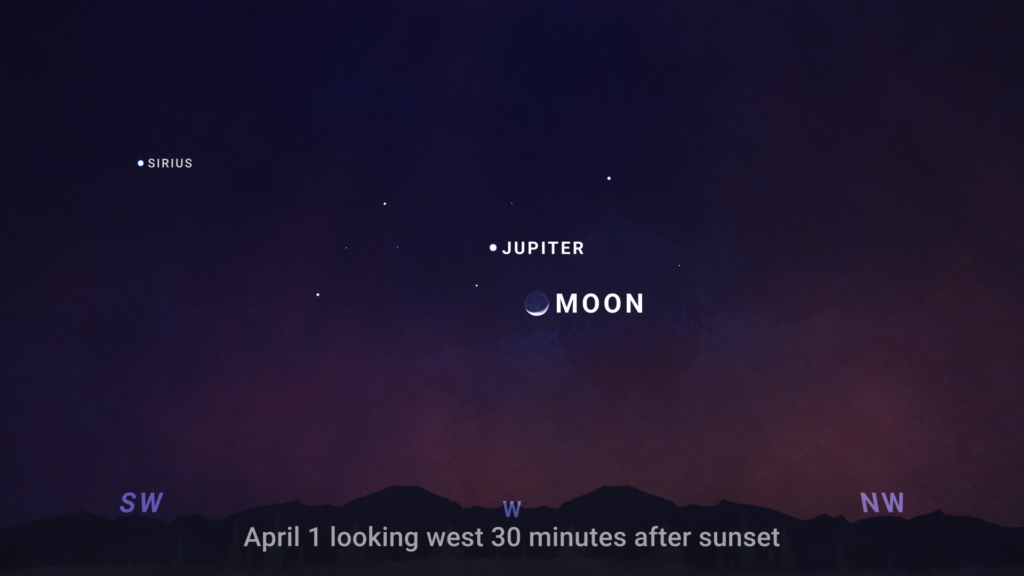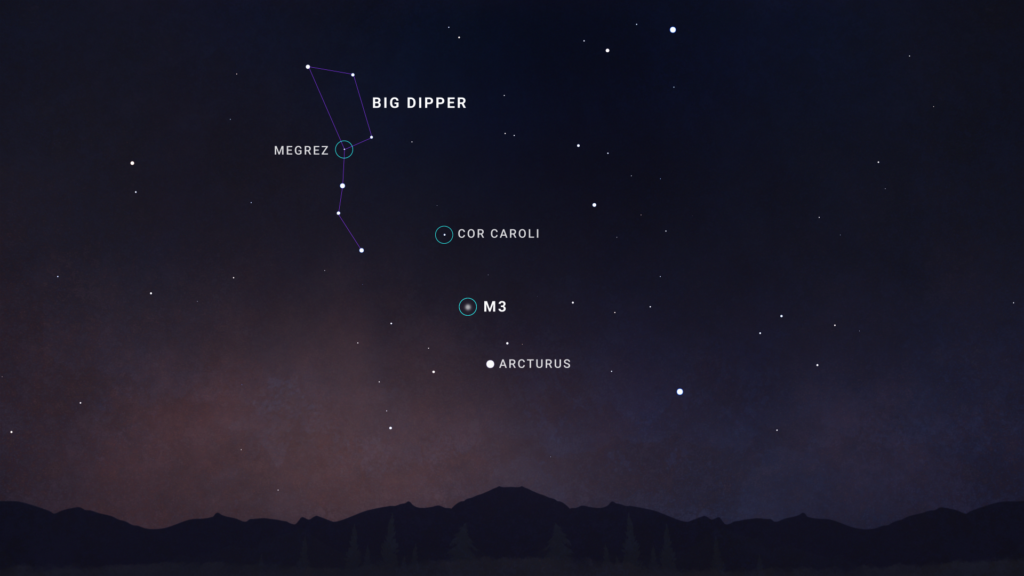
Introduction
April 2025 unfolds a celestial tapestry rich with opportunities for skywatchers of all levels. From the vibrant dance of planets across the morning and evening skies to the fleeting streaks of the Lyrid meteor shower and a deep dive into the ancient heart of our galaxy with the globular cluster M3, this month offers a truly diverse astronomical experience. This detailed guide, informed by NASA’s predictions, will equip you to fully appreciate the wonders on display.
April skywatching : Planetary Ballet – Morning and Evening Spectacles
April’s planetary lineup provides a captivating show, with several planets visible both before dawn and after sunset. Let’s explore each planetary visitor in detail:
- Mercury: The elusive Mercury presents a challenging, yet rewarding, observation opportunity. Visible only for a few days during the latter half of April, it appears extremely low on the eastern horizon before sunrise. You’ll need a clear, unobstructed view of the horizon and ideally, binoculars to spot this fleeting messenger of the gods. The low altitude and proximity to the sun make Mercury a tricky target, but successful observation provides a sense of accomplishment.
- Venus: April ushers in Venus as the brilliant “morning star.” Beginning low on the eastern horizon before dawn, it steadily climbs higher each day, becoming more easily visible as the month progresses. Its dazzling brightness, far surpassing any other star or planet in the morning sky, makes it impossible to miss. Take note of its increasing altitude throughout the month as it progresses in its orbit.
- Mars: The red planet dominates the evening sky throughout April, visible high overhead after sunset and remaining visible for several hours. Early in the month, Mars forms a striking celestial triangle with the bright stars Procyon and Pollux. However, keep in mind Mars’s orbital motion. Over the course of April, its position will shift noticeably against the background stars—approximately 12 degrees, or roughly the width of your outstretched fist at arm’s length. This apparent movement is a beautiful demonstration of our solar system’s dynamic nature.
- Jupiter: The king of planets, Jupiter, is a prominent feature in the western evening sky. Setting a couple of hours after sunset, Jupiter’s brilliance makes it readily identifiable even from locations with moderate light pollution. Use this opportunity to observe its four Galilean moons with even a small telescope – Io, Europa, Ganymede, and Callisto – offering a glimpse into the Jovian system.
- Saturn: Adding to April’s celestial delights, Saturn becomes visible in the east before dawn during the final two weeks of the month, nestled below Venus. Its rings, though not as spectacularly visible as in some other months, are still a rewarding observation with a telescope, showcasing the beauty of the ringed planet. The low altitude will require a clear, unobstructed eastern horizon for optimal viewing.
April Skywatching: Celestial Encounters – Planetary and Lunar Conjunctions
April offers several opportunities to witness captivating conjunctions, where celestial objects appear close together in the sky:
- April 1st & 30th: Jupiter and Crescent Moon: Start and end April with a stunning pairing of Jupiter and a slender crescent moon in the western sky after sunset. Their close proximity will create a visually striking spectacle, easily observed with the naked eye. Aim for about half an hour after sunset for the best viewing, before they dip below the horizon.
- April 4th & 5th: Mars and Moon: The first-quarter moon makes a graceful close approach to Mars, creating another captivating conjunction. Observe this duo high in the southern sky after dark.
- April 24th & 25th: A Planetary Trio with the Moon: A truly remarkable morning event unfolds as Venus, Saturn, and the crescent moon gather low in the east before dawn. For those with an unobstructed view of the low eastern horizon, the challenging but rewarding observation of Mercury, nestled below this trio, is also possible.
April Skywatching: Lyrid Meteor Shower – A Shower of Shooting Stars
- April’s celestial offerings include the Lyrid meteor shower, a moderate shower that peaks overnight on April 21st and into the morning of the 22nd.
- Under dark, clear skies, you can expect to see up to 15 meteors per hour near the peak. The best viewing time is from approximately 10:30 pm local time until dawn, with the most activity around 5:00 am.
- The waning crescent moon, only 27% full, will have a minimal impact on visibility. For optimal viewing, find a dark location far from city lights, lie down comfortably, and let your eyes adjust to the darkness.
April Skywatching: M3 – Unveiling a City of Stars – A Globular Cluster
- Beyond the planets and the meteor shower, April’s skywatching offers a unique opportunity to observe a truly ancient and distant object: the globular cluster M3.
- This April skywatching highlight, located approximately 34,000 light-years away in the outer halo of our Milky Way galaxy, is a vast spherical collection of hundreds of thousands of stars.
- Many of these stars are among the oldest known in the universe, estimated to be between 11 and 13 billion years old.
- This makes M3 a remarkable window into the early universe, providing a glimpse of stellar populations that formed shortly after the Big Bang.
- This April skywatching target is a testament to the immense scale and age of our galaxy.
- To locate M3 for your April skywatching session, begin with the easily identifiable Big Dipper.
- Follow the arc of its handle towards Arcturus, the fourth-brightest star in the night sky. From Arcturus, look higher in the sky towards Cor Caroli, a star of comparable brightness.
- M3 is situated roughly a third of the way between Arcturus and Cor Caroli. Even binoculars will reveal M3 as a faint, fuzzy patch of light.
- A small telescope will enhance the view, showing a more defined glow with a slightly grainy texture. Larger telescopes (8 inches or greater) will resolve the cluster into hundreds of individual stars, a truly breathtaking sight. Observing M3 is a rewarding experience for both beginner and seasoned astronomers, offering a tangible connection to some of the oldest objects in our galaxy and a highlight of your April skywatching activities.
Preparing for Your April Skywatching Adventures:

To maximize your April skywatching experience, remember these crucial points:
- Check the weather forecast: Clear skies are paramount for successful observation.
- Find a dark location: Light pollution significantly hinders visibility. The darker your location, the more celestial wonders you’ll be able to see.
- Use appropriate equipment: Binoculars are sufficient for most planetary observations and the meteor shower. A telescope will enhance your planetary views and is essential for resolving M3 into individual stars.
- Be patient: Astronomy often requires patience. Allow your eyes to fully adjust to the darkness, and take your time exploring the night sky.
- Consult star charts or apps: Numerous apps and online resources can aid in locating celestial objects and understanding the night sky.
- Dress warmly: Evenings and early mornings in April can be chilly, so dress appropriately to ensure your comfort.
April 2025 presents an exceptional opportunity to explore the wonders of the night sky. By utilizing this detailed guide and embracing the patience and preparation required, you can embark on a fascinating celestial journey, witnessing the beauty and wonder of our universe. Clear skies and happy April skywatching!
Your writing has a way of resonating with me on a deep level. I appreciate the honesty and authenticity you bring to every post. Thank you for sharing your journey with us.
Attractive section of content I just stumbled upon your blog and in accession capital to assert that I get actually enjoyed account your blog posts Anyway I will be subscribing to your augment and even I achievement you access consistently fast